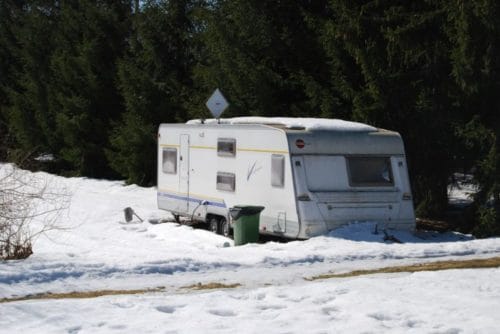Nothing strikes more fear into the heart of an RV buyer than accidentally buying a lemon. RVs are already rather infamous for mechanical problems. A true lemon will suck the cash out of your wallet and the time out of your summer.
When you’re shopping for an RV, you should definitely view our free inspection checklist here or download the expanded RV PDI checklist here from Etsy.com. These checklists (especially the expanded version) will walk you through a top-to-bottom inspection of any RV, new or used.
But if you’re just strolling through the sales lot or checking out an RV on Craigslist, how do you spot a lemon? (You don’t want to bust out a flashlight, a tape measure, and our 300-point checklist just for a 5-minute stroll-through, do you?)
What are some signs of RV build quality and physical condition that are easy to spot?
If you know these signs, you can walk (or run) away sooner rather than later! Don’t waste your time going any further.
Table of Contents
Some Rules of Buying an RV
We wrote a thorough introduction on How to Buy an RV. That’s a great place to start.
If you want to avoid buying a lemon RV, follow these five rules:
- Buy from a knowledge reseller, hopefully the original owner.
- Ask for maintenance records and part receipts.*
- Know your warranty inside and out.
- Be careful with a split warranty, like a 3+1 warranty, where the structure is covered by a 3-year warranty but everything else only for 1 year!
- RV warranties normally don’t cover 3rd party appliances like refrigerators, roof fans, air conditioners, etc.
- Never buy an RV sight unseen, regardless of how good the deal is!
- If possible, pay for a professional RV PDI inspector. If not, ask for a signed copy of the dealer’s PDI checklist.
- If buying from a dealer, ensure you receive at least a 24-hour warranty free from defects. This gives you implied merchantability, which can be a powerful lever in the courtroom!
*Make sure the VIN of the physical RV matches the paperwork records!
Here’s another reference article from an RV designer about how to judge RV construction quality at an RV show.
Research Manufacturer Recalls
You can research manufacturer recalls at NHTSA and RVTravel.com. Official safety recalls will be posted in these locations.
I feel bad for taking a pot shot at Forest River, but I can’t help but post this one from October 16, 2021:
“Forest River, Inc. (Forest River) is recalling some 2021-2022 Puma travel trailers. The black wastewater-holding tank may be missing the ventilation pipe, allowing methane gas to build up. In the presence of an ignition source, a build up of the methane gas could ignite and cause a fire and injury.”
Manufacturers may also issue service bulletins rather than recalls for problems or defects that fall outside the purview of highway safety regulations. These service bulletins are issued to network dealers and often posted on manufacturer’s websites. If you can’t find anything, call the manufacturer’s technical support phone line.
Do You Have a Lemon, or Just a Regular RV?
It’s a common joke that “the only thing that works on an RV is the owner!”
RVs are prone to breaking down. Almost all new RVs have a “shakedown period” (lasting anywhere from three months to two years) where the owner is in charge of tying up loose ends (sometimes literally loose ends) from the manufacturer or dealer.
It’s not uncommon to find plastic shavings in your water pump strainer, loose batten trim on the ceiling, water leaks through the roof penetrations, and other assorted problems.
Become good friends with your dealer. Take them to Olive Garden. Sponsor their child’s school fundraiser. Otherwise, you’ll be stuck with the rest of the crowd, waiting anywhere from four weeks to four months (sometimes more!) for your dealership to repair your RV. This is known as “repair event cycle time.”
Sadly, this sort of build quality and after-the-sale service is par for the course. That’s the ante for a life of adventure.
So here are some things you might see on a used RV that are “normal” (although not necessarily risk-free).
- Superficial rust on the chassis frame
- Faded vinyl flooring, yellowing cabinet vinyl wrap, peeling countertop laminate
- Minor dings and scratches (no bubbling!) on the walls
But there are still lemons amongst limes. If average is poor, you certainly don’t want to find yourself on the wrong end of the bell curve!
Follow Your Nose!
The smell of a camper interior can tell you a lot about how well it’s been maintained.
- Damp, musty odor
- Stored without proper ventilation
- External water leak
- Interior water leak
- Rotten egg smell
- Failing anode in your water heater
- Dirty freshwater tank (not properly sanitized)
- Dirty gray water tank with empty P traps.
- Propane leak*
- Fishy smell
- Ammonia leak
- Dead mouse
- Dead mouse
For more hints and tips on how to identify odors in an RV, check out this guide to troubleshooting common RV problems with your nose.
*If you suspect a propane leak, get out of there! By the time the propane level has risen high enough (propane is heavier than air) to reach your nostrils, you’re in imminent danger of being turned into a Roman Candle.
Look for Water and Mold Damage
Water damage is silent but deadly. It’s arguably the No. 1 Killer of all RVs.
Water damage can show up in the most unlikely of places. Water that leaks underneath a torn air conditioner gasket might not show up until it runs across the ceiling and down the wall behind the bedroom closest.
Sources of Water Leaks
Tracking water leaks is exceptionally difficult. It’s easier to conduct a full inspection of your RV interior and exterior, searching for common sources of leaks like:
- Cracked butyl tape behind window flanges
- Busted PEX crimp or swivel connections
- Loose PVC slip joints around P traps
- Cracked self-leveling roof sealant on roof penetrations
- Air gaps where the doors and windows seal against the weatherstripping
Common Leak Location Appearances
Here are the top three locations where to look for water damage inside the camper:
- Underneath the windows, both directly underneath the seal and at the subfloor-to-wall joint. Look for rippled or stained paneling, swollen OSB, and stained vinyl flooring
- At the ceiling along the roof-wall joint and around major roof penetrations such as the air conditioner, roof fan, and refrigerator vent
- Underneath appliances with outside vents, such as the refrigerator, water heater, and furnace
Common Signs of RV Water Damage
- Delaminated sidewalls
- Spongy subfloors
- Spongy roof decking
- Severely cracked or flaking roof caulk
- Rippled interior paneling
- Black mold inside cabinets
- Severe staining underneath the kitchen and bathroom sinks
If you see or feel any of these five signs, turn and run! You’re potentially looking at a five-figure fix.
P.S. Bonus hint: Peel back the flexible vinyl insert that runs inside the roof-edge and wall-edge aluminum trim. If the heads of the screws are deeply rusted, that’s a good sign there’s a water leak in that area.
Double-Check Appliance Operation
Before purchasing an RV, run all the appliances.
- The water heater should warm a full tank to at least 110 degrees within an hour of being operated on propane.
- Make sure the fridge gets cold (40 degrees or less) within 12 hours of being turned on.
- Run the freshwater system off the water pump and check water pressure, water smell.
- Operate the air conditioner (check the air filter!) and confirm it blows cold air (at least 20 degrees cooler than ambient air) within 5 minutes of being turned on.
- Turn on the propane furnace. Make sure it doesn’t enter the lock-out condition.
Inspect the Tires
RV tires are commonly neglected until one of them turns into a bomb. Be careful! Constant care of your tires is essential for RV safety.
- If the tires are more than five years old, they should be considered unsafe and replaced at the earliest possible time. This is regardless of their cosmetic condition.
- If the tires are more than 20 percent underinflated compared to the maximum allowable sidewall pressure, they have probably been habitually overloaded. They may have permanent and severe internal damage.
- If the tires have any cracking on the sidewalls or uneven wear across the tread, they will mostly need to be replaced.
- Check the tire camber. If the tires are severely bowed in one direction or the other, that may indicate a bent axle, which often happens after a wreck or a collision.
Examine the Caulking
If the caulking job looks older than your grandmother, then you’re looking at an RV that:
- A) was sealed with very poor quality materials
- B) hasn’t been stored indoors or underneath a cover
- C) hasn’t been properly re-sealed in a very, very long time
- D) all of the above
Test the Engine
If driving a motorhome, go for a test drive! Run the engine. Get under the hood.
- Check all fluid levels and condition
- Inspect air filter for cleanliness
- Listen for any rough idle or excessive diesel knocking
- Listen for any squealing belts
- Inspect spark plugs for oil fouling
- Use an OBD scanner to check for engine fault codes
We hope you’ve found these tips and tricks for inspecting an RV useful.
If you plan to purchase an RV, though, you’ve only seen the tip of the iceberg. Don’t buy a used or new RV without doing your due diligence!
- At a minimum, review our free online RV PDI Inspection Checklist.
- If you plan on conducting your own full RV inspection (it takes 2-4 hours!), then please download the full 300+ point inspection at Etsy.
- You can also pay for a professional RV inspection service from an NRVIA-certified inspector.
Andy Herrick is a blogging nerd, #8 Enneagram, wannabe bread baker, INTJ, RV industry professional, and small business entrepreneur. He can be found hanging out with his lovely wife and family, skiing, cycling, climbing, hiking, and convincing anyone who will listen why dogs aren’t really that great of pets. Also, he runs this website.
-
Andyhttps://changingears.com/author/andrew-herrick/
-
Andyhttps://changingears.com/author/andrew-herrick/
-
Andyhttps://changingears.com/author/andrew-herrick/
-
Andyhttps://changingears.com/author/andrew-herrick/









